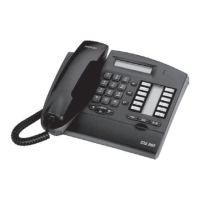IMPLEMENTING REFLEXES DECT SETS CALL SERVER : MOBILITY
Ed. 042/4 Réf. 3EH 21000 BSAA
REGISTRATION PROCEDURE FOR A PREVIOUSLY REGISTERED SET
If, during a registration attempt, the red indicator LED flashes "short ON/ long OFF", this means that
the set contains configuration data. To delete the data, proceed as follows:
- disconnect / reconnect the power supply;
- 2-3 seconds after switching on the power supply again, enter the following sequence of digits on
the keyboard: *#*86734#*# (which corresponds to the alphabet code *#*UNREG#*# using the
number keys); the first character must be entered within 10 seconds;
- again disconnect / reconnect the power supply; automatic registration as described in the para-
graph above is initialized.
General conditions of installation
- location: this office set must be located in an environment with limited risk of electro-magnetic dis-
turbance and which allows for good quality radio transmission. For example, avoid placing the set
near items such as dense metal structures, television, fluorescent strips, halogen lamps, PC moni-
tors, etc.
- PABX limits: a Reflexes DECT set is considered both as a Reflexes line set and a DECT terminal.
The installation must include a Reflexes corded set in order to perform the Operator function.
- radio operation: the Reflexes DECT set operates in dynamic DECT link mode (just like a conven-
tional DECT mobile) or static mode (just like a corded set). The communication channel is set up
with the base station each time there is a need to exchange data with the PABX. At the end of an
exchange, when the set is in stand-by mode, the radio link and communication channel resources
are released and made available to the base station.
- coverage study: this is performed in the conventional way, just as for a system equipped with
DECT mobile terminals. Apart from the specific use of the terminal as a static office set, it is recom-
mended that a sufficient radio level be maintained in order to guarantee excellent communication
quality.
- limits for standard traffic needs: the maximum number of Reflexes DECT terminals that can ope-
rate in the same zone is the following:
• for a zone covered by one radio base station (NOTE 1)
• 4070IO/EO base station with 3 channels: 4 sets
• 4070IO/EO base station with 6 channels: 12 sets
• for a zone covered by a group of co-located base stations (NOTE 2)
• cluster of two 4070IO/EO base stations with 6 channels: 30 sets
- cluster of three 4070IO/EO base stations with 6 channels: 50 sets
Notas :
1. irrespective of the model of the DECT set (any type of 4074, or Reflexes DECT)
2. the topology of co-located base stations is a specific solution that makes it possible to increase traffic
capacity in a given zone: this specific zone is thus identically covered by the various base stations that
make up the cluster. To set up a base station cluster it is necessary to make sure that the DECT sets are
compatible with this topology, which requires an overflow function not available on some DECT set
models.
Remarques :
- Operating and programming limits at system level (inherent in the dynamic DECT link opera-

